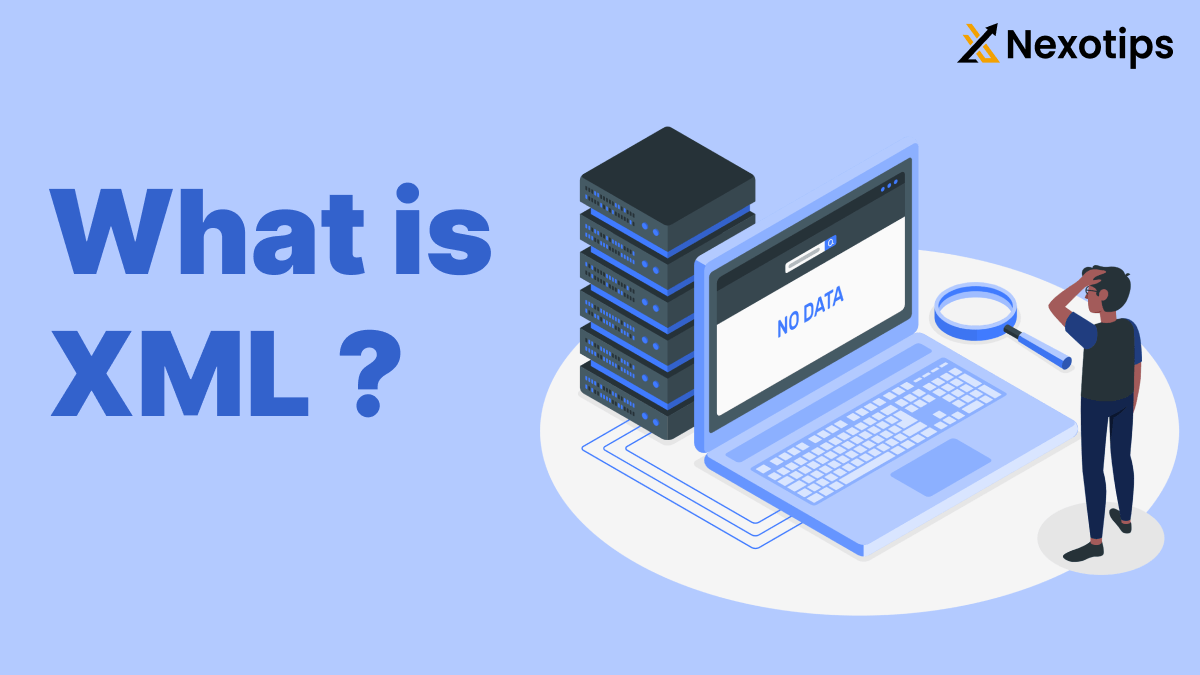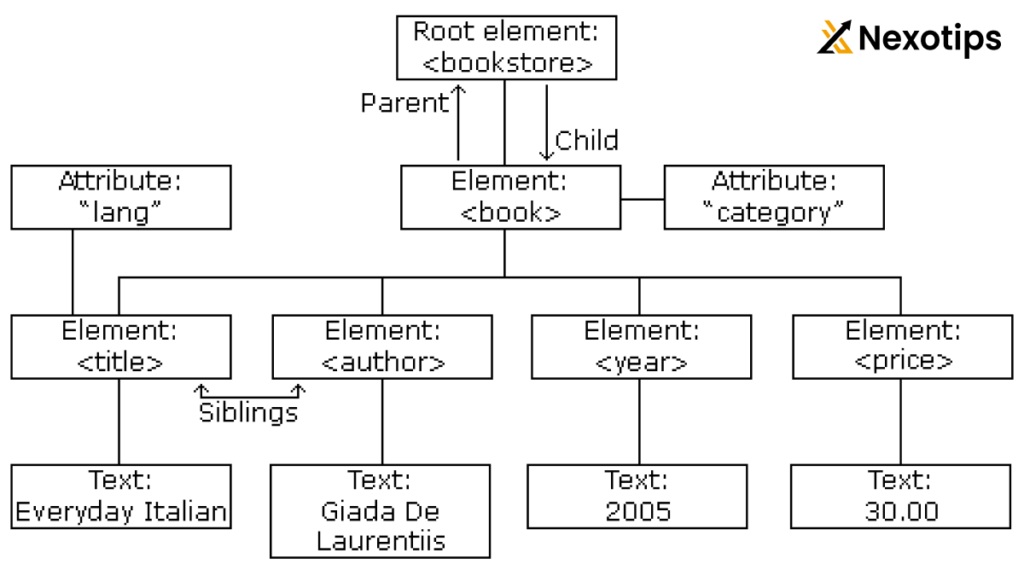
What is XML : Why We Can Use It Best explanation With Example on 2024
XML is essential in the digital era where data is king. For developers, organizations, and tech aficionados, efficiently and effectively managing, distributing, and preserving data is crucial. In this context, Extensible Markup Language, or XML, stands out as a fundamental tool. This blog will provide you with a comprehensive understanding of this powerful technology, delving into XML’s core structure, features, benefits, and best practices for producing XML code.
What is XML?
- eXtensible Markup Language is known as XML.
- Similar to HTML, XML is a markup language.
- It was intended to be self-descriptive and to store and transmit data.
- A W3C recommendation is XML.
The Difference Between XML and HTML
XML and HTML were created with distinct objectives in mind:
- With an emphasis on what data is, XML was created to transport data.
- HTML was created to present data, with an emphasis on the appearance of the data.
- Unlike HTML tags, which are predefined, XML tags are not
Why Make Use of XML?
Extensible Markup Language, or XML, is a versatile text format that was developed from SGML (ISO 8879). Its purpose is to convey and store data in a machine-readable and human-readable format. Here are a few explanations for the widespread usage of XML:
- Readability and Simplicity: XML is simple to use and comprehend. Because of its hierarchical nature, robots can understand it and people can read it.
- Platform-Independent: XML is adaptable and compatible with a variety of platforms and technologies as it is not dependent on any one programming language or operating system.
- Self-Descriptive: Metadata that describes and clarifies the material is included in XML documents using tags.
- Data Sharing: XML enables smooth communication and integration by facilitating data sharing across many applications, systems, and organizations.
- Extensibility: Because XML is extensible, users can build their own document structures and tags to suit their own requirements.
- Standardization: The W3C has acknowledged XML as a standardized format, providing consistency and interoperability between different implementations.
Basic XML Code and Description
To understand XML better, let’s start with a basic example:
<?xml version="1.0" encoding="UTF-8"?>
<bookstore>
<book category="fiction">
<title lang="en">The Great Gatsby</title>
<author>F. Scott Fitzgerald</author>
<year>1925</year>
<price>10.99</price>
</book>
<book category="non-fiction">
<title lang="en">Sapiens: A Brief History of Humankind</title>
<author>Yuval Noah Harari</author>
<year>2011</year>
<price>14.99</price>
</book>
</bookstore>Description of the Code:
- XML Declaration:
<?xml version="1.0" encoding="UTF-8"?>- This line declares the XML version and the character encoding used in the document.
- Root Element:
<bookstore>- The root element encapsulates all other elements within the XML document. In this example,
<bookstore>is the root element.
- The root element encapsulates all other elements within the XML document. In this example,
- Child Elements:
<book>- Each
<book>element represents a book and contains further nested elements.
- Each
- Attributes:
category="fiction"- Attributes provide additional information about elements. Here,
categoryis an attribute of the<book>element.
- Attributes provide additional information about elements. Here,
- Nested Elements:
<title>,<author>,<year>,<price>- These elements are nested within each
<book>element and contain data relevant to the book.
- These elements are nested within each
Features and Advantages of XML
Features:
- Hierarchical Structure: Data is arranged hierarchically in XML documents thanks to their tree-like structure.
- Flexibility: XML enables users to design unique document structures and tags based on particular requirements.
- Self-Reporting Nature: XML documents are self-explanatory because they contain information that explains the data they contain.
- Platform Independence: Because XML is not dependent on any one language or platform, it is widely compatible.
- Support for Unicode: XML has support for Unicode, which makes it possible to represent foreign characters.
- Validation: XML ensures data consistency and integrity by supporting validation via XML Schema and DTD (Document Type Definition).
Advantages with Example:
Cooperation:
XML allows for smooth communication across various systems. For instance, independent of the underlying technological stack, a web service can utilize XML to communicate data between a server and a client application.
<response>
<status>success</status>
<data>
<user>
<id>12345</id>
<name>John Doe</name>
<email>johndoe@example.com</email>
</user>
</data>
</response>Information Storage:
Configuration settings and other easily readable and editable data can be stored in XML files. An application’s configuration file, for example, may have the following format:
<configuration>
<database>
<host>localhost</host>
<port>3306</port>
<username>root</username>
<password>password</password>
</database>
<logging>
<level>INFO</level>
<file>app.log</file>
</logging>
</configuration>Information Exchange:
XML is frequently used to transfer data across various applications and systems. Product data might be sent from a supplier to a store, for instance, using an XML file.
<products>
<product>
<id>101</id>
<name>Smartphone</name>
<category>Electronics</category>
<price>299.99</price>
</product>
<product>
<id>102</id>
<name>Laptop</name>
<category>Computers</category>
<price>799.99</price>
</product>
</products>Best Practices for Writing XML Code
Use these recommended practices to make sure your XML code is legible, efficient, and maintainable:
Give Elements and Attributes Meaningful Names
To make the XML document self-explanatory, give your components and attributes names that are both straightforward and informative.
<order>
<orderID>12345</orderID>
<customerName>Jane Doe</customerName>
<orderDate>2024-05-20</orderDate>
<items>
<item>
<productID>567</productID>
<productName>Wireless Mouse</productName>
<quantity>2</quantity>
<price>25.99</price>
</item>
</items>
</order>Keep Formatting Consistent
Regular formatting makes text easier to read. Use line breaks correctly and indent nested components equally.
<employee>
<id>001</id>
<name>John Smith</name>
<department>Sales</department>
<salary>50000</salary>
</employee>Make Use of Documentation Comments
Comments make the XML document easier for others to read by clarifying the goals of the various parts.
<!-- Employee Details -->
<employee>
<id>002</id>
<name>Jane Doe</name>
<department>Marketing</department>
<salary>60000</salary>
</employee>Steer clear of redundant data
To maintain your XML document reasonable and succinct, avoid repeating data within it.
<books>
<book id="1">
<title>1984</title>
<author>George Orwell</author>
<genre>Dystopian</genre>
</book>
<book id="2">
<title>Brave New World</title>
<author>Aldous Huxley</author>
<genre>Dystopian</genre>
</book>
</books>Examine and Verify Your XML Files
To guarantee that your XML documents are legitimate and well-formed, describe their rules and structure using DTD or XML Schema.
<!DOCTYPE note [
<!ELEMENT note (to, from, heading, body)>
<!ELEMENT to (#PCDATA)>
<!ELEMENT from (#PCDATA)>
<!ELEMENT heading (#PCDATA)>
<!ELEMENT body (#PCDATA)>
]>
<note>
<to>Tove</to>
<from>Jani</from>
<heading>Reminder</heading>
<body>Don't forget me this weekend!</body>
</note>The XML Tree Structure
Extensible Markup Language, or XML, is well known for being a flexible and easy-to-use format for encoding structured data. The tree structure, which offers an orderly and transparent means of representing hierarchical data, is one of its fundamental characteristics. It is essential to comprehend this tree structure in order to use XML in a variety of applications, such as online services and data storage.

What is the structure of an XML tree?
A hierarchical architecture called the XML tree structure uses a tree to represent XML content. Each node in this tree represents a section of the document. Because XML is hierarchical, it can represent complicated data connections with ease, just how a file system arranges files and directories.
Components of the XML Tree
- The top-level element in an XML document that houses all other elements is called the root element. There can only be one root element in an XML document.
- components: that are nested inside other components are called child elements. A parent-child connection may be formed by each child element having its own child components.
- Attributes: Name-value pairs that are connected to an element and offer further details about it.
- Text Content: An element’s real data. Child components and text content can coexist.
- Comments: XML document notes or explanations that are not handled by the XML parser.
Example of an XML Tree Structure:
<?xml version="1.0" encoding="UTF-8"?>
<bookstore>
<book category="fiction">
<title lang="en">The Great Gatsby</title>
<author>F. Scott Fitzgerald</author>
<year>1925</year>
<price>10.99</price>
</book>
<book category="non-fiction">
<title lang="en">Sapiens: A Brief History of Humankind</title>
<author>Yuval Noah Harari</author>
<year>2011</year>
<price>14.99</price>
</book>
</bookstore>Visual Representation of the XML Tree:
bookstore
├── book (category="fiction")
│ ├── title (lang="en"): "The Great Gatsby"
│ ├── author: "F. Scott Fitzgerald"
│ ├── year: "1925"
│ └── price: "10.99"
└── book (category="non-fiction")
├── title (lang="en"): "Sapiens: A Brief History of Humankind"
├── author: "Yuval Noah Harari"
├── year: "2011"
└── price: "14.99"One effective and natural approach to describe hierarchical data is via an XML tree structure. It is a vital tool for data management, storage, and sharing across several domains because of its simplicity and versatility. By comprehending and using XML’s tree structure, developers and IT specialists may effectively arrange and work with complicated data, improving data integrity and interoperability.
You may fully utilize XML by becoming proficient with its tree structure, which will guarantee that your data is arranged, readable, and prepared for smooth interaction with other programs and systems.
In summary
The powerful and adaptable technology known as XML makes it easier to organize, share, and save data on a variety of platforms and systems. In today’s digital age, its self-descriptive, hierarchical, and expandable qualities make it essential. You can fully utilize XML and make sure your data is legible, easily shareable, and well-organized by adhering to best practices.
Using XML in your projects will definitely improve your capacity to manage complicated data in an efficient and effective manner, which is why it’s a crucial skill for both developers and IT workers.

